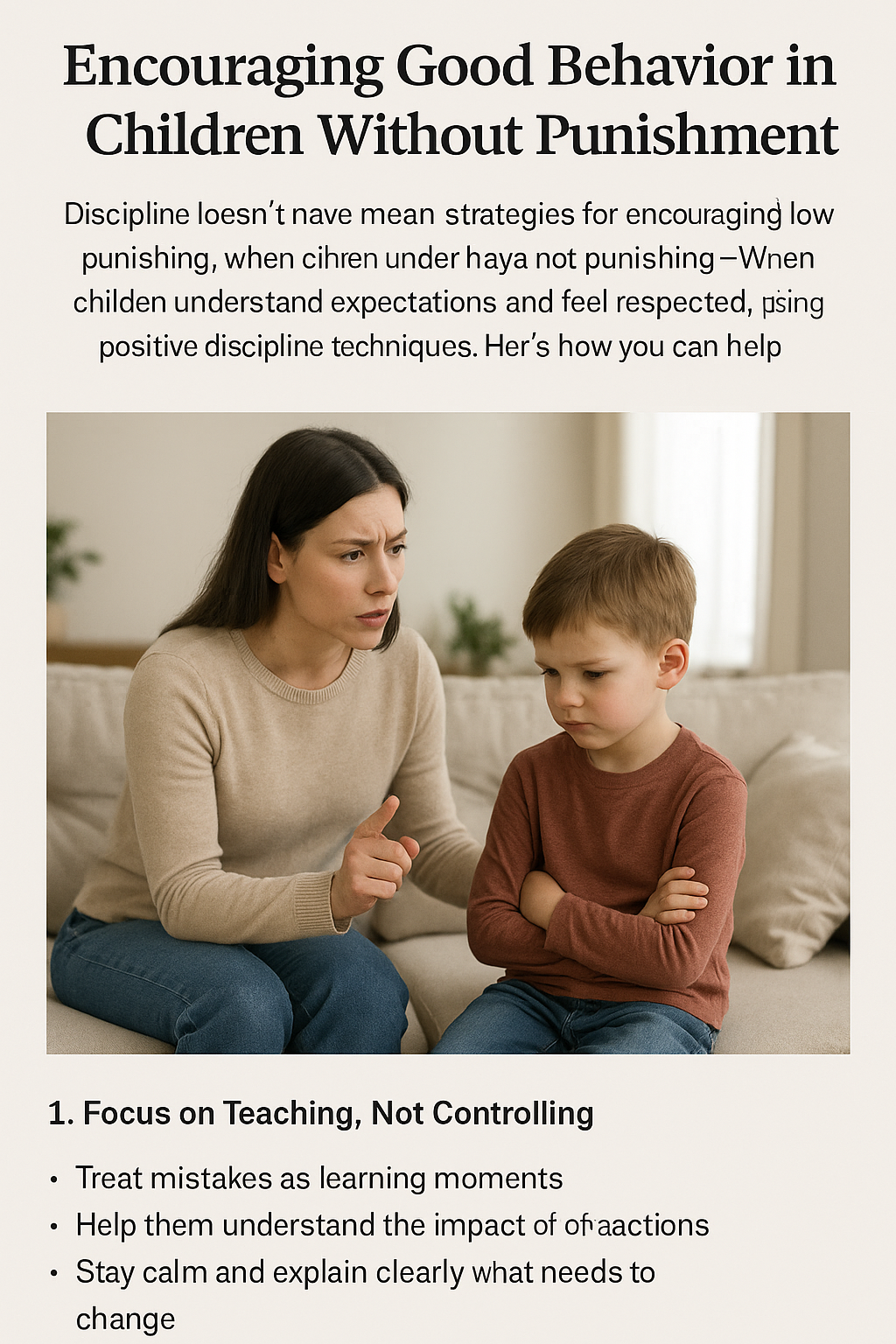Discipline doesn’t have to mean punishment. In fact, some of the most effective strategies for encouraging good behavior focus on teaching rather than punishing. When children understand expectations and feel respected, they’re more likely to cooperate, behave kindly, and grow into emotionally intelligent individuals. In this article, we’ll explore practical ways to guide your child’s behavior using positive discipline techniques.
1. Focus on Teaching, Not Controlling
The goal of discipline should be to teach children how to make good choices—not to control them through fear or shame
What you can do:
- Treat mistakes as learning moments
- Help them understand the impact of their actions
- Stay calm and explain clearly what needs to change and why
This approach promotes cooperation and long-term behavior change
2. Set Clear Expectations Ahead of Time
Children respond better when they know what’s expected before a situation begins
Examples:
- Before going to the store, say “We’re only buying what’s on our list today”
- Before a playdate, explain “We take turns and use kind words with our friends”
- Use visuals or checklists for younger children
Prevention is more effective than correction
3. Use Positive Reinforcement
Rather than only focusing on what your child does wrong, highlight what they do right
Try:
- Verbal praise: “Thank you for helping your sister, that was thoughtful”
- High-fives, hugs, and smiles to reinforce good moments
- Sticker charts or small rewards for younger kids
Positive reinforcement encourages repetition of desired behaviors
4. Redirect Instead of Saying “No” All the Time
Children often misbehave because they’re bored, frustrated, or don’t know what else to do. Redirection offers a solution rather than just a rejection
Examples:
- Instead of “Don’t jump on the couch,” say “Let’s jump on this pillow on the floor”
- Instead of “Stop yelling,” say “Use your inside voice, please”
This keeps the child engaged while guiding behavior in a better direction
5. Stay Calm During Misbehavior
Your reaction teaches more than your words. A calm, firm presence creates emotional safety and respect
How to stay calm:
- Take a deep breath before responding
- Lower your voice instead of raising it
- Step away briefly if you need time to regulate your own emotions
A calm adult helps a child learn how to calm themselves
6. Offer Choices Within Boundaries
Giving children choices helps them feel respected and in control, reducing power struggles
Examples:
- “Do you want to brush your teeth before or after getting dressed?”
- “You can clean up your toys now or after your snack”
Make sure both options are acceptable and aligned with your boundaries
7. Use Natural and Logical Consequences
Instead of unrelated punishments, let consequences teach the result of behavior
Examples:
- If a toy is thrown, it’s put away for the rest of the day
- If homework isn’t done, free time is shortened to finish it
- If they’re not ready on time, they miss a few minutes of playtime
These consequences make sense and encourage responsibility
8. Repair and Reconnect After Conflict
After discipline, make time to reconnect. This teaches that love doesn’t go away when behavior is challenging
Ways to reconnect:
- Offer a hug or gentle words: “I love you, even when we have hard moments”
- Reflect together: “What could we do differently next time?”
- Do something positive together like reading or playing
Repairing the bond teaches emotional resilience
9. Be Consistent, Not Harsh
Consistency builds trust and teaches children that your words have meaning. You don’t need to be strict—you need to be steady
Tips:
- Follow through calmly on consequences
- Avoid empty threats or big punishments you won’t enforce
- Keep discipline predictable and fair
Consistency helps children feel safe and know their limits
10. Model the Behavior You Want to See
Children learn by watching. If you want kindness, patience, and honesty from them—start by demonstrating it yourself
What to model:
- Saying “please” and “thank you”
- Admitting when you’re wrong
- Handling conflict respectfully
Your actions are your child’s most powerful example
Discipline That Builds Trust
Discipline isn’t about punishment—it’s about guidance, respect, and teaching. By using positive, respectful strategies, you create a relationship based on trust, not fear. This kind of discipline encourages lasting behavior change and builds the foundation for a strong, supportive connection between you and your child
